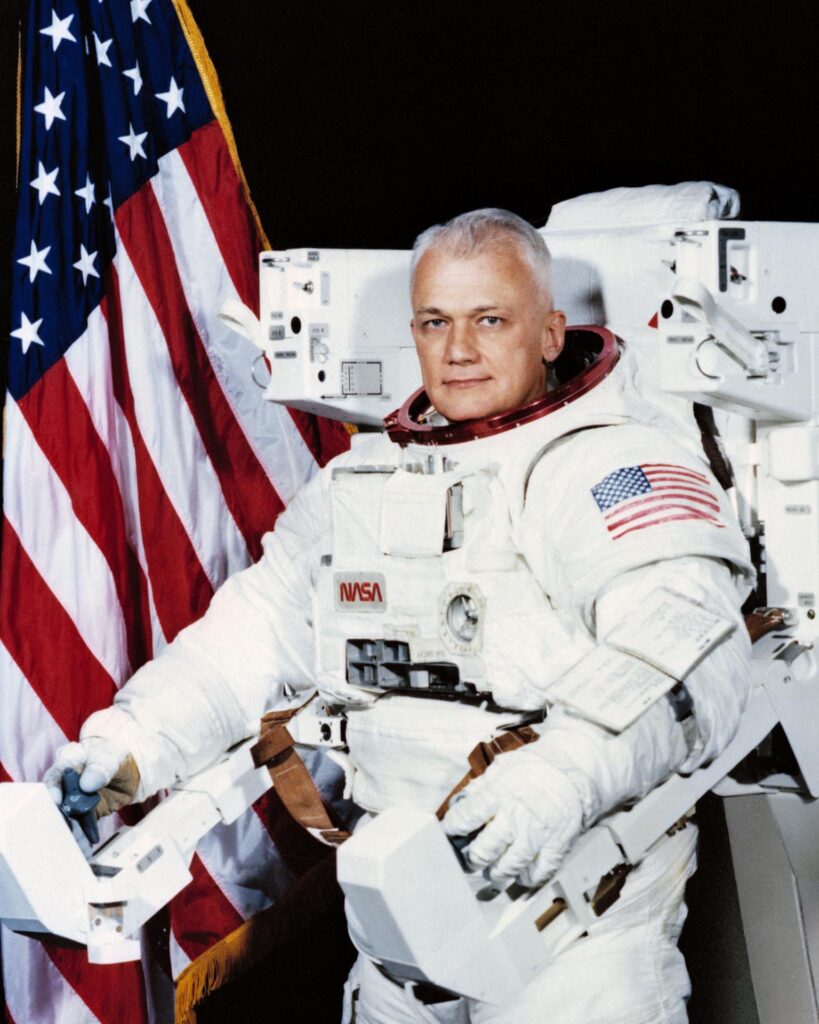Bruce McCandless II was born June 8, 1937, in Boston, Massachusetts. His father was Rear Admiral Bruce McCandless, who won the Congressional Medal of Honor for his heroism during the Naval Battle of Guadalcanal, November 13, 1942. A graduate of Woodrow Wilson Senior High School in Long Beach, California, Bruce received a Bachelor of Science degree from the United States Naval Academy in 1958, a Master of Science degree in Electrical Engineering from Stanford University in 1965, and a Masters degree in Business Administration from the University of Houston at Clear Lake in 1987.
Bruce McCandless II was second in his class of 899 at Annapolis. He received flight training from the Naval Aviation Training Command in Pensacola, Florida, and Kingsville, Texas. He became a naval aviator in March of 1960 and was stationed in Key West, Florida, for weapons system and carrier landing training in the F-6A Skyray. His next duty was with Fighter Squadron 102 (VF-102) from December 1960 to February 1964, flying the Skyray and the F-4B Phantom II. During this period he served aboard the aircraft carriers the USS Forrestal and the USS Enterprise, including the latter’s participation in the Cuban Blockade in October and November 1962.
After three months as an instrument flight instructor in Attack Squadron 43 at the Naval Air Station in Oceana, Virginia, McCandless reported to the Naval Reserve Officer’s Training Corps Unit at Stanford University, for graduate studies in electrical engineering. He has gained flying proficiency in the T-33B Shootingstar, T-38A Talon, F-4B Phantom II, F-6A Skyray, F-11 Tiger, TF-9J Cougar, T-1 Seastar, and T-34B Mentor airplane, and the Bell 47G helicopter. He has logged more than 5,200 hours flying time, including 5,000 hours in jet aircraft.
McCandless was one of nineteen astronauts selected by NASA in April 1966. He was a member of the astronaut support crew for the Apollo 14 mission in 1971, and in 1973 was backup Pilot for the first manned Skylab mission (SL-2). He was a co-investigator on the M-509 astronaut maneuvering unit experiment that was flown in the Skylab Program. He collaborated on the development of the Manned Maneuvering Unit (MMU) used during Shuttle extravehicular activities (EVA’s). He was responsible for crew input for the development of hardware and procedures for the Inertial Upper Stage of the Space Telescope, the Solar Maximum Repair Mission, and the Space Station Program.
Mission Specialist Bruce McCandless first entered space on STS-41B Challenger, launched from Kennedy Space Center (KSC), Florida on February 3, 1984. During the flight, the deployment of two Hughes 376-series communications satellites, and rendezvous sensors and computer programs were flight tested for the first time.
STS-41B was the first checkout of the Manned Maneuvering Unit (MMU), and the Manipulator Foot Restraint. McCandless made the first untethered, free flight with each of the two MMU’s carried on board and alternated with Mission Specialist Robert L. Stewart in the activities constituting two spectacular extravehicular activities. As he floated free of the Shuttle, McCandless became the first “human satellite.” The eight-day orbital flight ended with the first landing on the runway at KSC on February 11, 1984, after 191 hours in space (including four hours of MMU flight time by McCandless).
His second spaceflight was STS-31 Discovery, launched from KSC on April 24, 1990. During the five-day mission, the crew deployed the Hubble Space Telescope and conducted a variety of mid-deck experiments involving the study of protein crystal growth, polymer membrane processing, and the effects of weightlessness and magnetic fields on an ion arc. They also operated a variety of cameras, including the IMAX in-cabin and cargo bay cameras, for earth observations from a record-setting altitude of 380 miles. Following 76 orbits STS-31 Discovery landed at Edwards Air Force Base, California, on April 29, 1990.
Bruce McCandless II has logged over 312 hours in space. He holds one patent for the design of a tool tethering system that is currently used during Shuttle “spacewalks.” After retiring from the Navy as a captain on August 31, 1990, he also retired from NASA. Captain McCandless currently makes his home in Conifer, Colorado.
Bruce McCandless II has received many awards, including the Legion of Merit (1988); the Department of Defense Distinguished Service Medal (1985); the National Defense Service Medal; the American Expeditionary Service Medal; NASA’s Exceptional Service Medal (1974); the American Astronautical Society Victor A. Prather Award (1975 and 1985); NASA’s Space Flight Medal (1984); the NASA Exceptional Engineering Achievement Medal (1985); the National Aeronautic Association Collier Trophy (1985); and the Smithsonian Institution National Air and Space Museum Trophy (1985).

